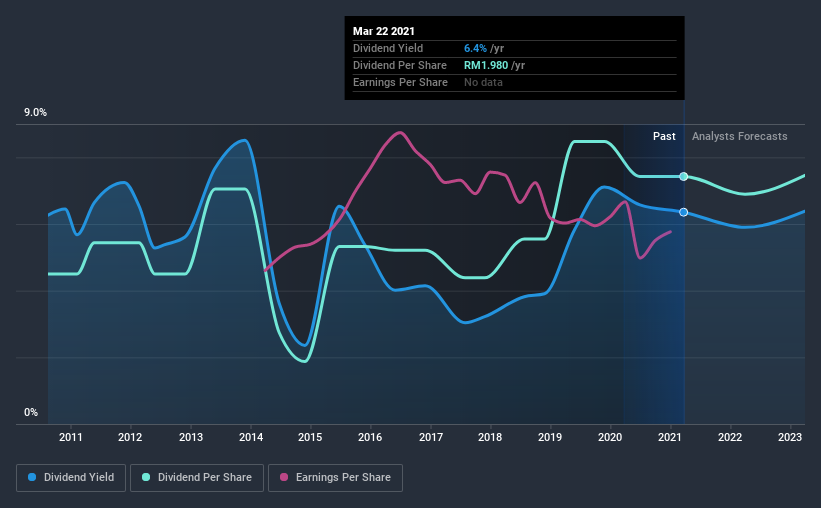- Malaysia
- /
- Consumer Durables
- /
- KLSE:PANAMY
Does It Make Sense To Buy Panasonic Manufacturing Malaysia Berhad (KLSE:PANAMY) For Its Yield?

Could Panasonic Manufacturing Malaysia Berhad (KLSE:PANAMY) be an attractive dividend share to own for the long haul? Investors are often drawn to strong companies with the idea of reinvesting the dividends. On the other hand, investors have been known to buy a stock because of its yield, and then lose money if the company's dividend doesn't live up to expectations.
In this case, Panasonic Manufacturing Malaysia Berhad likely looks attractive to investors, given its 6.4% dividend yield and a payment history of over ten years. It would not be a surprise to discover that many investors buy it for the dividends. Some simple research can reduce the risk of buying Panasonic Manufacturing Malaysia Berhad for its dividend - read on to learn more.
Explore this interactive chart for our latest analysis on Panasonic Manufacturing Malaysia Berhad!

Payout ratios
Companies (usually) pay dividends out of their earnings. If a company is paying more than it earns, the dividend might have to be cut. As a result, we should always investigate whether a company can afford its dividend, measured as a percentage of a company's net income after tax. Looking at the data, we can see that 119% of Panasonic Manufacturing Malaysia Berhad's profits were paid out as dividends in the last 12 months. A payout ratio above 100% is definitely an item of concern, unless there are some other circumstances that would justify it.
Another important check we do is to see if the free cash flow generated is sufficient to pay the dividend. Panasonic Manufacturing Malaysia Berhad paid out 311% of its free cash last year. Cash flows can be lumpy, but this dividend was not well covered by cash flow. Paying out such a high percentage of cash flow suggests that the dividend was funded from either cash at bank or by borrowing, neither of which is desirable over the long term. As Panasonic Manufacturing Malaysia Berhad's dividend was not well covered by either earnings or cash flow, we would be concerned that this dividend could be at risk over the long term.
While the above analysis focuses on dividends relative to a company's earnings, we do note Panasonic Manufacturing Malaysia Berhad's strong net cash position, which will let it pay larger dividends for a time, should it choose.
Remember, you can always get a snapshot of Panasonic Manufacturing Malaysia Berhad's latest financial position, by checking our visualisation of its financial health.
Dividend Volatility
Before buying a stock for its income, we want to see if the dividends have been stable in the past, and if the company has a track record of maintaining its dividend. Panasonic Manufacturing Malaysia Berhad has been paying dividends for a long time, but for the purpose of this analysis, we only examine the past 10 years of payments. This dividend has been unstable, which we define as having been cut one or more times over this time. During the past 10-year period, the first annual payment was RM1.2 in 2011, compared to RM2.0 last year. Dividends per share have grown at approximately 5.1% per year over this time. The dividends haven't grown at precisely 5.1% every year, but this is a useful way to average out the historical rate of growth.
Dividends have grown at a reasonable rate, but with at least one substantial cut in the payments, we're not certain this dividend stock would be ideal for someone intending to live on the income.
Dividend Growth Potential
With a relatively unstable dividend, it's even more important to see if earnings per share (EPS) are growing. Why take the risk of a dividend getting cut, unless there's a good chance of bigger dividends in future? It's not great to see that Panasonic Manufacturing Malaysia Berhad's have fallen at approximately 5.5% over the past five years. If earnings continue to decline, the dividend may come under pressure. Every investor should make an assessment of whether the company is taking steps to stabilise the situation.
Conclusion
When we look at a dividend stock, we need to form a judgement on whether the dividend will grow, if the company is able to maintain it in a wide range of economic circumstances, and if the dividend payout is sustainable. Panasonic Manufacturing Malaysia Berhad paid out almost all of its cash flow and profit as dividends, leaving little to reinvest in the business. Second, earnings per share have been in decline, and its dividend has been cut at least once in the past. There are a few too many issues for us to get comfortable with Panasonic Manufacturing Malaysia Berhad from a dividend perspective. Businesses can change, but we would struggle to identify why an investor should rely on this stock for their income.
It's important to note that companies having a consistent dividend policy will generate greater investor confidence than those having an erratic one. Still, investors need to consider a host of other factors, apart from dividend payments, when analysing a company. Taking the debate a bit further, we've identified 2 warning signs for Panasonic Manufacturing Malaysia Berhad that investors need to be conscious of moving forward.
Looking for more high-yielding dividend ideas? Try our curated list of dividend stocks with a yield above 3%.
If you’re looking to trade Panasonic Manufacturing Malaysia Berhad, open an account with the lowest-cost* platform trusted by professionals, Interactive Brokers. Their clients from over 200 countries and territories trade stocks, options, futures, forex, bonds and funds worldwide from a single integrated account. Promoted
New: Manage All Your Stock Portfolios in One Place
We've created the ultimate portfolio companion for stock investors, and it's free.
• Connect an unlimited number of Portfolios and see your total in one currency
• Be alerted to new Warning Signs or Risks via email or mobile
• Track the Fair Value of your stocks
This article by Simply Wall St is general in nature. It does not constitute a recommendation to buy or sell any stock, and does not take account of your objectives, or your financial situation. We aim to bring you long-term focused analysis driven by fundamental data. Note that our analysis may not factor in the latest price-sensitive company announcements or qualitative material. Simply Wall St has no position in any stocks mentioned.
*Interactive Brokers Rated Lowest Cost Broker by StockBrokers.com Annual Online Review 2020
Have feedback on this article? Concerned about the content? Get in touch with us directly. Alternatively, email editorial-team (at) simplywallst.com.
About KLSE:PANAMY
Panasonic Manufacturing Malaysia Berhad
Manufactures and sells electrical home appliances and related components under the Panasonic brand name in Malaysia, Japan, rest of Asia, Europe, the Middle East, and internationally.
Flawless balance sheet with reasonable growth potential.
Market Insights
Community Narratives



